| Pages:
1
2 |
Ritter
Hazard to Others
  
Posts: 370
Registered: 20-6-2008
Location: Earth
Member Is Offline
Mood: Curious
|
|
More on CW agent codes
From various official documents found on the Internet:
The anticholinergic agent BZ (QNB, Ro-2-3308) was scheduled to be phased out in favor of EA 3834, which is said to have the same
incapacitating effects but was faster acting (and possibly shorter acting). No pilot plant or other scale-up work was done on EA
3834.
BZ was said to turn test subjects into 'zombies' for at least 3 days & that they would require full-time medical care while under its influence.
This incapacitating effect is very different from the aggression-releasing effects produced by the agent used in the story line of the movie
Jacob's Ladder.
Interestingly, US patent 4190471 (to Dow Chemical under contract to the U.S. Army) is for 'Pyrotechnic Disseminating Formulations.' It states that
| Quote: | | ...problems have been encountered in disseminating certain agents such as those coded BZ, EA 3834, and EA 3850 by means of
pyrotechnic munitions. |
These munitions consisted on 40-60% of the active agent & the rest being a polymeric binder & an oxidizer. When this mixture buirned, an
aerosol of the active agent was produced.
The structures of BZ, EA 3834 & EA 3850 are in the attached ChemDraw graphic.
It is interesting to note the substitution of the N-methylpiperidinol in the 4-position rather than in the 3-position found in BZ & in the
JB-series of psychotomimetic anticholinergic drugs (Ditran, etc).
Another similar piperidinol agent under development was said to be EA 3382 but I have been unable to locate its structure.
[Edited on 13-7-2008 by Ritter]

Ritter
=============================
\"The production of too many useful things results in too many useless people.\"
Karl Marx
|
|
|
Sauron
International Hazard
    
Posts: 5351
Registered: 22-12-2006
Location: Barad-Dur, Mordor
Member Is Offline
Mood: metastable
|
|
Well, this much I can tell you.
The N-methylpiperidyl compounds with EA (Edgewood Arsenal) numbers are much less potent than the quinuclidinyl -3-ol esters such as BZ.
The most potent of the series was the a-phenyl-a-cyclopentyl ester of quinuclidinol. It had a smaller ED50 and its effects lasted up to 2 weeks.
The main clinical investigator of all these was the late Dr.Leo Abood, a scientist rather controversial for his work for the tobacco companies.
Those esters based on 3-hydroxy-N-alkylpiperidines were all developed originally as pharmaceuticals, first as candidate beta blockers, then in
experimental psychiatry under the name Ditran.
They also had a brief and unexceptional career as street drugs but never achieved popularity.
Several of the Ditran series are DEA Scheduled controlled substances.
BZ was a dismal military failure, its effects were unpredictable, and it is being destroyed at great expense to the taxpayers.
These are incapacitants, and non-lethal. In my view they are in same category as riot control agents and ought not be trayed as chemical weapons or
most certainly not weapons of mass destruction.
And in the end they DID NOT WORK. That is why the Army dropped BZ.
The specific antidote for these b the way is tetrahydroacridine.
Biochemically they are related to scopalamine, atropine etc. only far more potent and longer acting.
Sic gorgeamus a los subjectatus nunc.
|
|
|
Sauron
International Hazard
    
Posts: 5351
Registered: 22-12-2006
Location: Barad-Dur, Mordor
Member Is Offline
Mood: metastable
|
|
For further information I recommend you obtain the two part study entitled "Possible Long Term Health Effects of Short-Term Exposure to Chemical
Agents" which was commissioned by the Whte House and conducted by the National Academy of Sciences, ultimately published by the National Academy
Press, and available free online.
http://www.nap.edu/openbook.php?record_id=740
Volume I published in 1982 and Volume II in 1984
http://books.nap.edu/openbook.php?record_id=9136&page=10...
You will also find it in the ftp site because I uploaded it to there.
The study was on the military's volunteer testing program on soldiers to determine the effects of a wide variety of standard and experimental agents
ranging from mustard and lewisite through the OPAs and psychotomimetics like LSD, PCP and BZ.
The study assesses the long term health impacts. The White House was caught flatfooted by Agent Orange and did not want another self inflicted
surprise.
There is an appendix by Dr Leo Abood on the development and structure-activity relationsips in the N-alylpiperidyl and quinuclidinyl benzilates and
homogs etc.
Also a good set of references.
However in the end BZ and relatives were failures. Effects were idiosyncratic and unpredictable. Some subjects were terrified, some became violent and
berserk. Not what the Army wanted.
These things failed as street drugs because they were very very very unpleasant and no one wanted to try them twice.
[Edited on 13-7-2008 by Sauron]
Sic gorgeamus a los subjectatus nunc.
|
|
|
Ritter
Hazard to Others
  
Posts: 370
Registered: 20-6-2008
Location: Earth
Member Is Offline
Mood: Curious
|
|
| Quote: | Originally posted by Sauron
The most potent of the series was the a-phenyl-a-cyclopentyl ester of quinuclidinol. It had a smaller ED50 and its effects lasted up to 2 weeks.
|
You mean EA 3167 (ChemDraw attached).
So no idea as to the structure of EA 3382?
There are 2 compounds described in one of those National Academy of Science reports on long-term health effects. They are listed as 302,282 &
302,537, the first (EA 3382 under another name?) an N-methyl-4-piperidinol with an unsaturated phenyl glycolic acid & the second the BZ analog
with a cyclopentyl unsaturated alkyl side chain that is described as
| Quote: | | having a potency comparable to EA 3580 & somewhat greater that that of [BZ]. |
[Edited on 13-7-2008 by Ritter]
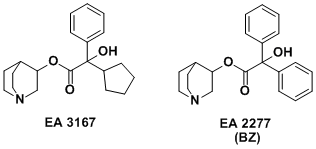
Ritter
=============================
\"The production of too many useful things results in too many useless people.\"
Karl Marx
|
|
|
Sauron
International Hazard
    
Posts: 5351
Registered: 22-12-2006
Location: Barad-Dur, Mordor
Member Is Offline
Mood: metastable
|
|
The compound you have labeled as EA 3167 is the one Abood stated was most potent in the series.
None of the piperidyl esters were even close to BZ and EA 3167 was a lot more potent than BZ as well as longer lasting.
Also bear in mind that if the racemate that is BZ is resolved, one stereoisomer turns out to be 100X more potent than the other. Therefore, that
isomer is 2X more potent than the racemate.
The Army though was not interested in such finesse and also not very interested in the non-symmetrical benzilic acids. They opted to produce the much
easier to manufacture symmetrical benzilic acid (a-diphenyl-a-hydroxy acetic acid) ester of quinuclidinol. It was the only one of the series ever mass
produced. The others were just experimental. That's what EA numbers mean. Edgewood Arsenal's candidate agents. There are thousands of such. Because
these are now regarded as having no military significance and because they were less than lethan "incap" agents I have pretty much lost interest in
them. The chemistry is all very familiar (if you want to know how to make 3-quinuclidinone, it;s in Org.Syn., while benzilic acid is in Vogel and many
other standard texts.) The SARs and pharmacology are interesting. The pharm industry has found some uses for related esters as spasmolytics un
treatment of bladder diseases. But of course they engineered all the CNS activity out - IIRC by quaternization.
Sic gorgeamus a los subjectatus nunc.
|
|
|
Ritter
Hazard to Others
  
Posts: 370
Registered: 20-6-2008
Location: Earth
Member Is Offline
Mood: Curious
|
|
| Quote: | Originally posted by Sauron
The compound you have labeled as EA 3167 is the one Abood stated was most potent in the series.
Also bear in mind that if the racemate that is BZ is resolved, one stereoisomer turns out to be 100X more potent than the other. Therefore, that
isomer is 2X more potent than the racemate.
The Army though was not interested in such finesse and also not very interested in the non-symmetrical benzilic acids. They opted to produce the much
easier to manufacture symmetrical benzilic acid (a-diphenyl-a-hydroxy acetic acid) ester of quinuclidinol. It was the only one of the series ever mass
produced. . |
EA 3167 has 2 chiral centers & therefore can exist as a mixture of 4 diasteriomers (R/R, S/S, R/S & S/R). I'd be curiious about whether or not
the Edgewood program ever went that far with this compound.
Ritter
=============================
\"The production of too many useful things results in too many useless people.\"
Karl Marx
|
|
|
Ritter
Hazard to Others
  
Posts: 370
Registered: 20-6-2008
Location: Earth
Member Is Offline
Mood: Curious
|
|
Another compound from this 1982 report is WIN 2299 (from what was then Sterling Winthrop Pharmaceutical Co).
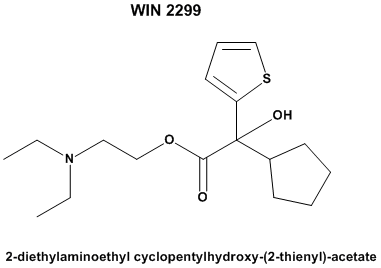
Ritter
=============================
\"The production of too many useful things results in too many useless people.\"
Karl Marx
|
|
|
Ritter
Hazard to Others
  
Posts: 370
Registered: 20-6-2008
Location: Earth
Member Is Offline
Mood: Curious
|
|
And Ditran (JB-329/CS 4297), a compound that came out of 1950s research at Lakeside Labs in Milwaukee.
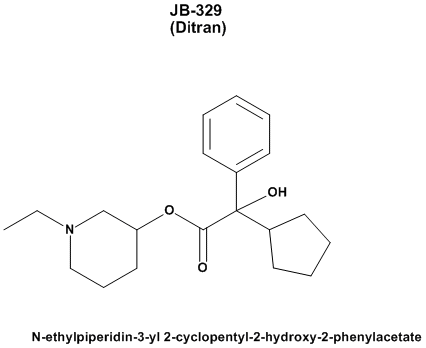
Ritter
=============================
\"The production of too many useful things results in too many useless people.\"
Karl Marx
|
|
|
Ritter
Hazard to Others
  
Posts: 370
Registered: 20-6-2008
Location: Earth
Member Is Offline
Mood: Curious
|
|
| Quote: | Originally posted by Sauron
For further information I recommend you obtain the two part study entitled "Possible Long Term Health Effects of Short-Term Exposure to Chemical
Agents" which was commissioned by the Whte House and conducted by the National Academy of Sciences, ultimately published by the National Academy
Press, and available free online.
http://www.nap.edu/openbook.php?record_id=740
Volume I published in 1982 and Volume II in 1984
http://books.nap.edu/openbook.php?record_id=9136&page=10...
There is an appendix by Dr Leo Abood on the development and structure-activity relationsips in the N-alylpiperidyl and quinuclidinyl benzilates and
homogs etc.
|
Be careful with these references. I noted that the structure for Ditran in Volume 1 is incorrect. The structure shown is an incorrect hemiacetal
rather than the correct glycolate ester.
Ritter
=============================
\"The production of too many useful things results in too many useless people.\"
Karl Marx
|
|
|
Sauron
International Hazard
    
Posts: 5351
Registered: 22-12-2006
Location: Barad-Dur, Mordor
Member Is Offline
Mood: metastable
|
|
Yeah I know that the assymetrical benzilate has two chiral centers, but I was referring to BZ itself, in which the ester moiety is achiral. The sole
chiral cener is on the quinuclidine cage. This it can be resolved as the alcohol prior to esterification.
Not that it matters.
Lakeside Labs conveniently in Milwaukee, as is Aldrich. I have always suspected this was not a coincidence and that Alfred Bader was involved.
Ditran (and therefore all of the benzilate/glycollates) was an accident.
The original candidate b-blocker was derived from tetrahydrofurfuryl alcohol, a product of agro-industry (Quaker Oats mostly) That is 2-THF-methanol.
Halogenate that, then replace with an amino group.
You now have tetrahydrofurfurylamine. They were looking at derivatives of that, the sal;ient portion of the molecule being the N-C-C-O choline-like
part.
Upon fractionation, it was found that this compound underwent ring opening and rearrangement to 3-hydroxypiperidine and that samples of candidate
esters containing this impurity had unexpected and potent psychotomimetic effects. And that is the origin of Ditran An accident. A thermodynamic
chemical reshuffling of the five membered O heterocycle with side chain at 2 position to six mebered N-heterocycle substituted at 3-position with
hydroxyl. The side chain amino of the THF derivative is now the ring nitrogen and the ring oxygen is now the 3-hydroxyl.
The choline-like N-C-C-O structure remain.
The more active compounds were those rearranged from mono-alkylamine derivatives such as N-Me and N-Et. So Abood and coworkers (IIRC) reasoned that
connecting the beta carbon of the N-Et group to the 4-position of the piperidyl ring might be interesting. This they did by a Dieckmann condensation,
to form 1-aza-[2.2.2]bicyclooctan-3-one, better known as 3-quinuclidone. Reduction of this ketone with LAH affords the alcohol, now as the racemate.
The appropriate esters of this turned out to have vastly more potency, and it is easy to understand why.
the N-alkylpiperidyl esters are flexible and undergoing chair-boat transitions constantly. So a favored conformation for the docking of the ester to
its receptor site in the brain only happens part of the time.
The bicyclic cage is very rigid, there is no chair-boat, and the lobe electron pair on N is constantly exposed. This rigidity and its implications
are what give the 3-quinuclidin0l esters their properties.
Now couple that rigidity to the preferred isomer at the 3-carbon and you have real insight into the most favored conformation for docking.
Sic gorgeamus a los subjectatus nunc.
|
|
|
Sauron
International Hazard
    
Posts: 5351
Registered: 22-12-2006
Location: Barad-Dur, Mordor
Member Is Offline
Mood: metastable
|
|
In the very first JACS paper describing the 3-hydroxypiperidyl benzilate antispamodics, Biel and coworkers (Lakeside Labs) made a very early reference
to Paul's 1945 paper in Comptes Renus 231 560-562 describing the preparation of N-alkyl-3-hydroxypiperidines from either furfural (furfuraldehyde) or
from tetrahydrofurfuryl bromide, in two steps.
I present here the Paul paper.
Furfural is readily obtained by the dilute acid hydrolysis of oat hulls, corncobs, rice husks, etc.
Furfural when reacted with ethylamine under pressure and with Raney nickel catalyst gives the N-ethyl-3-hydroxypiperidine.
With methylamine the analogous reaction takes place.
[Edited on 14-7-2008 by Sauron]
Attachment: cr231_560.pdf (227kB)
This file has been downloaded 575 times
Sic gorgeamus a los subjectatus nunc.
|
|
|
Ritter
Hazard to Others
  
Posts: 370
Registered: 20-6-2008
Location: Earth
Member Is Offline
Mood: Curious
|
|
| Quote: | Originally posted by Sauron
Lakeside Labs conveniently in Milwaukee, as is Aldrich. I have always suspected this was not a coincidence and that Alfred Bader was involved.
Ditran (and therefore all of the benzilate/glycollates) was an accident.
|
John Biel (not Biels) worked at Aldrich in the late 1960s after leaving Lakeside Labs. He ran their medicinal chemistry research labs at St Paul Ave.
I'm sure he and Alfred were friends as the chemical business in Milwaukee is a small club.
Ditran (JB-329) came out of work at Lakeside Labs to prepare an extensive series of N-alkyl-3-piperidinol benzilates. If you look at the attached
structures you can see that Ditran was the result of a systematic medicinal chemistry program & was not an 'accident.'
As a side note, Aldrich sold large quantities of European 3-hydroxypyridine to Roche-U.S. in that time period. I am under the impression that it was
used as a feedstock to make 3-quinuclidinol via a process that may not have been published, which makes sense as Roche discovered & patented BZ in
the early 1950s. A pharma company like Roche would have had the specialized pilot plant & materials handling equipment to make BZ in multi-kg lots
for Army testing.
[Edited on 14-7-2008 by Ritter]
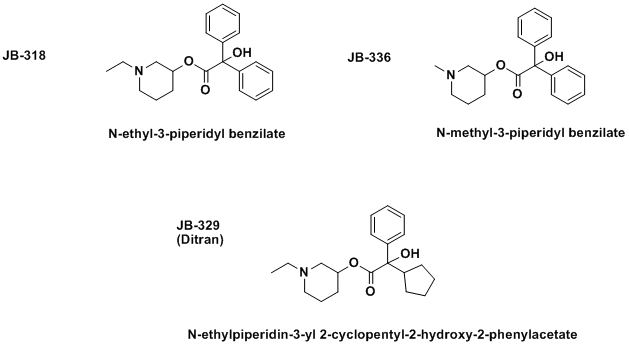
Ritter
=============================
\"The production of too many useful things results in too many useless people.\"
Karl Marx
|
|
|
Sauron
International Hazard
    
Posts: 5351
Registered: 22-12-2006
Location: Barad-Dur, Mordor
Member Is Offline
Mood: metastable
|
|
The accident I am talking about was the discovery of the psychotomimetic effects as a consequence of unanticipated rearrangement of the systematically
developed substituted furan, a candidate spasmolytic, to the corresponding piperidine. The resulting mixture of the two is what was found to have the
bizarre effects, isolation of the piperidyl benzilate from the mixture established it was the active compound. THE systematic search for beta-blocking
antocholinergics turned into a systematic search for psychoactive compounds.
I studied this literature extensively in the 1970s, including Abood's work, Bie;'s work, papers from Roche chemists, etc. I am now retracing my steps
from 30 years ago. Ditran the spamolytic was no accident; Ditran the experimental psychtomimetic for psychiatric use, was. And THAT is what the BZ
program came from.
Here's Biel's first paper (in JACS, 1952) describing the work on spasmolytics at Lakeside Labs, starting from the French "furan" process described
upthread.
As you can see in this paper 3-hydroxypyridine was indeed a feedstock but for reduction to the 3-hydroxypiperidine and alkylation to the desired
tertiary aminoalcohol. Making 3-quinuclidinol from that would not be trivial. The accepted process is to start with gamma-oicoline, oxidize that to
the isonicotinic acid, wsterify that, N-alkylate it, reduce to the isonipeconic acid ester, and do a Dieckmann using potassium metal. That gets you
3-quinuclidone. Reduce that with LAH and what have you got?
That's right out of Org.Syn.
If you say Roche had a different route I am willing to believe you but I doubt it was a better route.
[Edited on 14-7-2008 by Sauron]
Attachment: s2.pdf (591kB)
This file has been downloaded 663 times
Sic gorgeamus a los subjectatus nunc.
|
|
|
Sauron
International Hazard
    
Posts: 5351
Registered: 22-12-2006
Location: Barad-Dur, Mordor
Member Is Offline
Mood: metastable
|
|
Actually there are two different rearrangements:
The first is the ring expansion occuring duirng the reductive amination of furfural with a primary amine, to give the N-alkyl-3-hydroxypiperidine
The other is the ring contraction of the esters of the 3-hydroxypiperidine to give the correspondine pyrrolidinol with a longer side chain.
See the paper cited below from J.Org.Chem
I guess I was confusing the two.
That's what I get for trying to go by a 30 year old memory.
To my basic point I will adhere. The goal of these studies at the onset was to develop spasmolytics. The observation that bizarre psychological
effects were present was serendipitous - a happy accident but stiill an accident. The selection of the combination of the 3-hydroxypepieridines made
available by Paul's furan process, and the benzilic acids were based onlogical sound medicinal-chemical principles. No one planned any psychotropic
effects. Once these were observed of course they went after them hammer and tongs.
Central Stimulants. II. Cholinergic Blocking Agents1
JOHN H. BIEL, LEO G. ABOOD, WALLACE K. HOYA, HELEN A. LEISER, PATRICK A. NUHFER, E. F. KLUCHESKY
J. Org. Chem.; 1961; 26(10); 4096-4103. DOI: 10.1021/jo01068a108
[Edited on 15-7-2008 by Sauron]
Sic gorgeamus a los subjectatus nunc.
|
|
|
Ritter
Hazard to Others
  
Posts: 370
Registered: 20-6-2008
Location: Earth
Member Is Offline
Mood: Curious
|
|
| Quote: | Originally posted by Sauron
The accident I am talking about was the discovery of the psychotomimetic effects as a consequence of unanticipated rearrangement of the systematically
developed substituted furan, a candidate spasmolytic, to the corresponding piperidine. The resulting mixture of the two is what was found to have the
bizarre effects, isolation of the piperidyl benzilate from the mixture established it was the active compound. THE systematic search for beta-blocking
antocholinergics turned into a systematic search for psychoactive compounds. |
I don't think this was an unexpected discovery. For instance, the psychoactivity of the Atropa & Datura alkaloids had been known
since the 1930s, so esterified piperidinols would be expected to have activity of this sort. Hallucinations were also known to result from cocaine
poisoning. An accidental overdose of benactyzine caused hallucinations (1958). And BZ was discovered in 1953, a long time before Lakeside synthesized
Ditran. Biel & Abood knew what they were looking for. They were modifying the atropine molecule in order to optimize the psychotomimetic &
other effects. (See attached graphic to see the structural similarity between atropine, benactyzine & Ditran).
| Quote: | I studied this literature extensively in the 1970s, including Abood's work, Biel's work, papers from Roche chemists, etc. I am now retracing my steps
from 30 years ago. Ditran the spamolytic was no accident; Ditran the experimental psychtomimetic for psychiatric use, was. And THAT is what the BZ
program came from.
As you can see in this paper 3-hydroxypyridine was indeed a feedstock but for reduction to the 3-hydroxypiperidine and alkylation to the desired
tertiary aminoalcohol. Making 3-quinuclidinol from that would not be trivial. The accepted process is to start with gamma-picoline, oxidize that to
the isonicotinic acid, wsterify that, N-alkylate it, reduce to the isonipeconic acid ester, and do a Dieckmann using potassium metal. That gets you
3-quinuclidone. Reduce that with LAH and what have you got?
[Edited on 14-7-2008 by Sauron] |
Their application for that 3-hydroxypyridine is only speculation on my part. Their patented process (US2648667) starts from methyl isonicotinate, as
you outlined above. Here is the first Biel reference:
| Quote: | | J Am Chem Soc 1955, 77, 2250 |
[Edited on 14-7-2008 by Ritter]
[Edited on 14-7-2008 by Ritter]
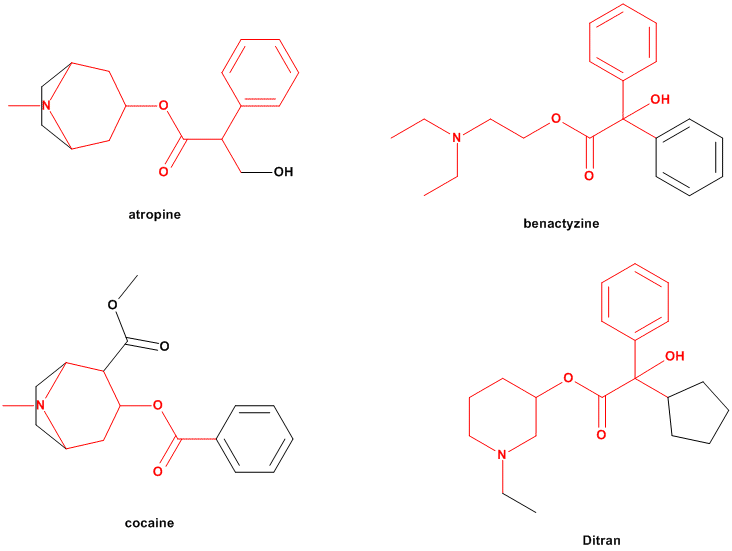
Ritter
=============================
\"The production of too many useful things results in too many useless people.\"
Karl Marx
|
|
|
Ritter
Hazard to Others
  
Posts: 370
Registered: 20-6-2008
Location: Earth
Member Is Offline
Mood: Curious
|
|
| Quote: | Originally posted by Ritter
So no idea as to the structure of EA 3382?
There are 2 compounds described in one of those National Academy of Science reports on long-term health effects. They are listed as 302,282 &
302,537, the first (EA 3382 under another name?) an N-methyl-4-piperidinol with an unsaturated phenyl glycolic acid & the second the BZ analog
with a cyclopentyl unsaturated alkyl side chain that is described as
|
The compound identified as 302,282 (EA 3382?) in the NAS Appendix 1 appears in a 1984 patent to FMC, one of the main contractors on the BZ project.
In work at their pesticide R&D facility outside Princeton, NJ, they synthesized a number of analogs of BZ & 3- & 4-piperidinyl benzilates.
The compound in the ChemDraw attachment is described as one of a number of examples in US4465834 Table 4, Example 4. Not coincidentally, it is one of
the more potent compounds listed in Table 14 (ED50 = .03, LD50 = 25. And it is one of the few compounds where 'mydriasis times' are given. In this
case these are 'Onset 16 minutes, Duration 119 minutes.'
I would offer the assumption that the compounds with the 6-digit numerical codes were those evaluated from outside sources, such as FMC, rather than
those actually made at Edgewood (which were given 4-digit EA codes).
[Edited on 14-7-2008 by Ritter]
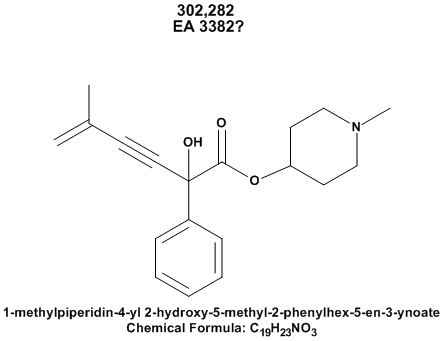
Ritter
=============================
\"The production of too many useful things results in too many useless people.\"
Karl Marx
|
|
|
Ritter
Hazard to Others
  
Posts: 370
Registered: 20-6-2008
Location: Earth
Member Is Offline
Mood: Curious
|
|
The compound identified as 302,537 in Appendix 1 is not listed specifically in the FMC patent but it is quoting a source that I am not able to check
in order to verify its identity. It says 'Brown (247) stated that the ester of 2-propenylcyclopentylglycolic acid with 3-quinuclidinol (302,537) is a
potent antimuscarinic compound with profound effects on the central nervous system and with a potency comparable with that of EA 3580 and somewhat
greater than that of [BZ].' Curiously, the compound that is one of the most potent of those listed in the patent is the double-bond cis
isomer shown in the ChemDraw attachment.
Potency was given as follows (Table 16):
ED50=.008
LD50=56
Mydriasis times:
Onset=30 minutes
Duration=120 minutes (both with the footnote of 'partial mydriasis')
Interestingly, the cis isomer is many times more potent than the trans isomer.
Given the stated draft nature of these online documents, there is a reasonable chance that this compound is 302,537.
[Edited on 14-7-2008 by Ritter]
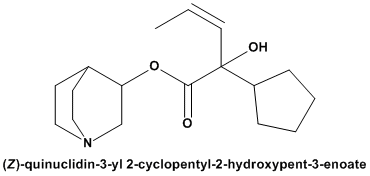
Ritter
=============================
\"The production of too many useful things results in too many useless people.\"
Karl Marx
|
|
|
Sauron
International Hazard
    
Posts: 5351
Registered: 22-12-2006
Location: Barad-Dur, Mordor
Member Is Offline
Mood: metastable
|
|
Actually Biel published a paper in JACS in 1952 (three years prior to your citation) describing the appearance of the Paul furan process to
3-hydroxypiperidines as inspiring the investigation of esters of same as spasmolytics because of the similarity of the N-C-C-O (choline-like) linkag.
The paper's title included the phrase "Spasmolytics I" marking at as first of a series. (It is posted upthread as s2.pdf.)In this paper the
modifications to the various Paul procedures developed at Lakeside Labs were described as Paul's reductive amination gave low yields there and
elsewhere. Biel and co-workers were able to double them. A variety of routes to the required substitutes glycollic acids were also described along
with several esterification methods. It is quite apparent that this work was begun in the immediate postwar period, and was well under way in 1948
because Biel notes a 1948 parallel publication by another laboratory that was pertinent to the problem of proof of structure. (The other lab prepared
the hydroxypyridine by reduction of 3-piperidone.) Since Paul's paper appeared in 1945 my best estimate of the start of Biel's investigations would be
1946 and certainly not later than 1947.
By 1958 Biel and Abood were publishing the first reports of the (entirely unanticipated) bizarre psychotomimetic effects. See the footnotes 5 and 6 in
the J.D.Cannon paper posted below.
In all of the papers published between 1952 and the first papers to describe the bizarre effects in animals and humsns, which appeared in the late
1950s, all attention was paid to spasmolytic, which is to say anticholinergic, activity, usually as tested on the excised guinea pig ileum. No mention
is made at any time to hallucinatory effects.
Indeed, spasmolytic potencies were generally lower than those of atropine. It is true that historically belladonna has been used in warfare since
medieval times. But there is no evidence that Biel and colleagues or even competitors were searching for or anticipating the possibility of
hallucinatory effects; they were after anticholinergics.
Therefore I conclude on the basis of negative evidence that the greatly enhanced psychotomimetic effects of this series, relative to atropine etc.,
were unexpected and therefore accidental. I am willing to be corrected, if any indication can be found predating the publication of such effects, that
Lakeside Labs' workers, or Abood their collaborator at the University of Illionois Medical School, was expecting or anticipating such effects. It
appears to be absent from the record.
[Edited on 15-7-2008 by Sauron]
Attachment: s3.pdf (434kB)
This file has been downloaded 609 times
Sic gorgeamus a los subjectatus nunc.
|
|
|
chemoleo
Biochemicus Energeticus
    
Posts: 3005
Registered: 23-7-2003
Location: England Germany
Member Is Offline
Mood: crystalline
|
|
Very educational, I must say!
Coming from a *therapeutic* drug synthesis angle, I am baffled that so many utterly noxic compounds have been synthesised, which are perfectly capable
of blocking various enzymes, and pathways, whilst, for instance, only a handful of targeted molecular (targeted) drugs exist to battle cancer
(without any (major) side effects) and numerous other diseases.
Now that I'm thinking about it:
I guess the goal here, with these compounds, is molecular, cellular, and ultimately organismal (in that order) 'destruction' , which is always easier
to achieve than targeted rescue or indeed targeted killing of cells! Indeed, 95% of all cancer drugs work that way - destruction of all things
proliferating, rather than destruction of all things proliferating *excessively* (the difference is very distinctive indeed!)
Presumably it is a lesson to be learned, even on a molecular level: Within the 'chemical space' of drugs, there's a much greater probability for
destruction than achieving beneficial cellular and organismal effects!
I think the myriads of failed (pre-)clinical trials will attest here.
From a broader perspective, this holds within evolution (deleterious *destructive* mutations are way more common than beneficial ones), or even human
society altogether - it is easier to destroy than to build or repair....
So, whilst this is interesting, is design of such compounds an art or a science at all, compared to the scientific complexity of actually doing
something good?
Just a little philosophical teaser, if you like.
[Edited on 15-7-2008 by chemoleo]
Never Stop to Begin, and Never Begin to Stop...
Tolerance is good. But not with the intolerant! (Wilhelm Busch)
|
|
|
Sauron
International Hazard
    
Posts: 5351
Registered: 22-12-2006
Location: Barad-Dur, Mordor
Member Is Offline
Mood: metastable
|
|
Ah, but cancer chemotherapy got its very start owing to the development of the nitrogen "mustards" so it really IS an illwind that blows no good.
Seriously, the pharm companies are always on the lookout for highly toxic substances (synthetic or natural) because they like to take those structures
that possess such potent physiological action and twist them around to use as therpeutics. Medical anaesthetics, skeletal muscle relaxants all sorts
of things. Even the subject of this thread BZ has been tweaked to remove the mind altering effects and use it as a spasmolytic.
Saxitoxin, the shellfish toxic principle, is used as a standard in kits to detect the presence of same in mussels fopr human consumption. This
directly saves lives in the Pacific northweat of USA and Canada.
I have not heard of any positive uses for ricin but I am sure medical science learned a lot from it.
Sic gorgeamus a los subjectatus nunc.
|
|
|
Sauron
International Hazard
    
Posts: 5351
Registered: 22-12-2006
Location: Barad-Dur, Mordor
Member Is Offline
Mood: metastable
|
|
Here's the paper in which the ring contration of esters of 3-hydroxy-N-alkylpiperidines e.g. Ditran is described. The result is a mixture of the
starting material (30-40%) and the corresponding N-alkyl-2-pyrrolidinemethanol ester. As discussed the rearrangement only occurs under specific
conditions and can be reversed.
Specifically, if the crude esters were converted to their salts, without first subjecting them to a high vacuum distillation, the main product was the
5-membered heterocycle.
If the high vacuum distillation was performed, before or after conversion to the salt, the expected 6-membered heterocycle was sole product.
My recollection is that the manufacturer (either Lakeside Labs or Roche) initially cut a corner in the process, and some of this mixture made it into
the hands of clinicians before the problem was noted, investigated and corrected. I do not specifically recall what effect this had on the
pharmacological (or military) profile of the compound. But anyway they fixed this, and now it remains an interesting cautonary tale in the literature.
As we will see this rearrangement is not limited to the esters.
[Edited on 15-7-2008 by Sauron]
Attachment: jo01068a108.pdf (977kB)
This file has been downloaded 799 times
Sic gorgeamus a los subjectatus nunc.
|
|
|
Sauron
International Hazard
    
Posts: 5351
Registered: 22-12-2006
Location: Barad-Dur, Mordor
Member Is Offline
Mood: metastable
|
|
On left: an N-ethyl-3-piperidyl ester
At right: ring contraction contaminent 60-70%
[Edited on 15-7-2008 by Sauron]
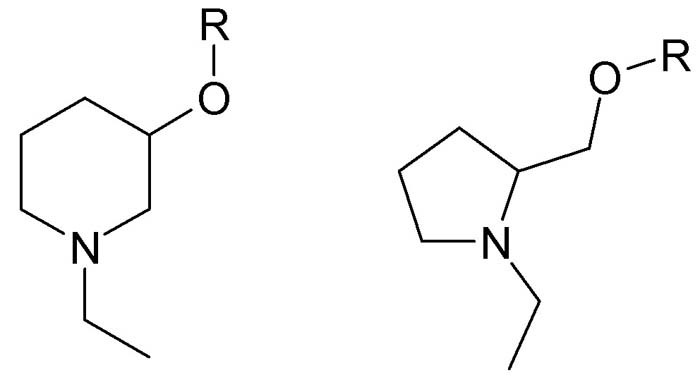
Sic gorgeamus a los subjectatus nunc.
|
|
|
Ritter
Hazard to Others
  
Posts: 370
Registered: 20-6-2008
Location: Earth
Member Is Offline
Mood: Curious
|
|
Attached is a ChemDraw of the most potent of the compounds described in the FMC patent. Its Army code is unknown.
Toxicity/potency (Table 15):
ED50=.003
LD50=79
Mydriasis:
Onset=15 minutes
Duration=223 minutes
The patent nomenclature is not completely clear on this structure as it is listed twice, once with the suffix (A) & once with the suffix (B).
Since there is no cis/trans isomerism possible, it is not clear what the difference is between these 2 forms.
[Edited on 15-7-2008 by Ritter]
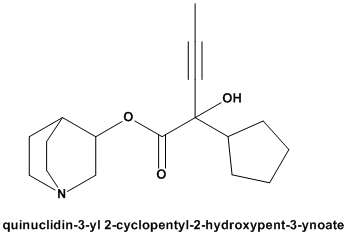
Ritter
=============================
\"The production of too many useful things results in too many useless people.\"
Karl Marx
|
|
|
JohnWW
International Hazard
    
Posts: 2849
Registered: 27-7-2004
Location: New Zealand
Member Is Offline
Mood: No Mood
|
|
Ritter,
In those last two compounds of which you have provided ChemDraw structures, the C atom bonded to the -OH, cyclopentyl, ester, and ethenyl or ethynyl
groups, is asymmetric and optically active, giving rise to the possibility of each having two stereoisomers. Do you know which stereoisomer of each is
the one made and used as a CW agent, or are they racemic mixtures?
|
|
|
Ritter
Hazard to Others
  
Posts: 370
Registered: 20-6-2008
Location: Earth
Member Is Offline
Mood: Curious
|
|
| Quote: | Originally posted by JohnWW
Ritter,
In those last two compounds of which you have provided ChemDraw structures, the C atom bonded to the -OH, cyclopentyl, ester, and ethenyl or ethynyl
groups, is asymmetric and optically active, giving rise to the possibility of each having two stereoisomers. Do you know which stereoisomer of each is
the one made and used as a CW agent, or are they racemic mixtures? |
That's a valid observation but the patent does not mention optical isomers or their preparation, either of the starting ester intermediates or the
final products. No mention of the A & B notation found in the table could be found to explain their significance.
As a note of explanation, the toxicity/potency numbers are in mg/kg (rat).
[Edited on 15-7-2008 by Ritter]
Ritter
=============================
\"The production of too many useful things results in too many useless people.\"
Karl Marx
|
|
|
| Pages:
1
2 |